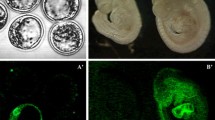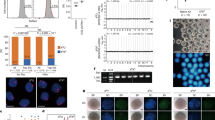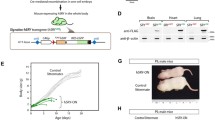Abstract
Known examples of male to female sex reversal in mice are caused by either strain incompatibilities or mutations in genes required for male sex determination. The resultant XY females are often sterile or exhibit very poor fertility. We describe here embryonic stem (ES) cell growth conditions that promote the production of healthy, anatomically normal fertile and fecund female F0 generation mice completely derived from gene-targeted XY male ES cells. The sex reversal is a transient trait that is not transmitted to the F1 progeny. Growth media with low osmolality and reduced sodium bicarbonate, maintained throughout the gene targeting process, enhance the yield of XY females. As a practical application of the induced sex reversal, we demonstrate the generation of homozygous mutant mice ready for phenotypic studies by the breeding of F0 XY females with their isogenic XY male clonal siblings, thereby eliminating one generation of breeding and the associated costs.




Similar content being viewed by others
References
Angelow S, Ahlstrom R, Yu AS (2008) Biology of claudins. Am J Physiol Renal Physiol 295:F867–F876
Bagheri-Fam S, Sim H, Bernard P, Jayakody I, Taketo MM, Scherer G, Harley VR (2008) Loss of Fgfr2 leads to partial XY sex reversal. Dev Biol 314:71–83
Barrionuevo F, Bagheri-Fam S, Klattig J, Kist R, Taketo MM, Englert C, Scherer G (2006) Homozygous inactivation of Sox9 causes complete XY sex reversal in mice. Biol Reprod 74:195–201
Bogani D, Siggers P, Brixey R, Warr N, Beddow S, Edwards J, Williams D, Wilhelm D, Koopman P, Flavell RA et al (2009) Loss of mitogen-activated protein kinase kinase kinase 4 (MAP3K4) reveals a requirement for MAPK signalling in mouse sex determination. PLoS Biol 7:e1000196
Brewster JL, de Valoir T, Dwyer ND, Winter E, Gustin MC (1993) An osmosensing signal transduction pathway in yeast. Science 259:1760–1763
Bronson SK, Smithies O, Mascarello JT (1995) High incidence of XXY and XYY males among the offspring of female chimeras from embryonic stem cells. Proc Natl Acad Sci USA 92:3120–3123
Chaboissier MC, Kobayashi A, Vidal VI, Lutzkendorf S, van de Kant HJ, Wegner M, de Rooij DG, Behringer RR, Schedl A (2004) Functional analysis of Sox8 and Sox9 during sex determination in the mouse. Development 131:1891–1901
Colvin JS, Green RP, Schmahl J, Capel B, Ornitz DM (2001) Male-to-female sex reversal in mice lacking fibroblast growth factor 9. Cell 104:875–889
Costa AG, Cusano NE, Silva BC, Cremers S, Bilezikian JP (2011) Cathepsin K: its skeletal actions and role as a therapeutic target in osteoporosis. Nat Rev Rheumatol 7:447–456
Eicher EM, Washburn LL, Whitney JB 3rd, Morrow KE (1982) Mus poschiavinus Y chromosome in the C57BL/6 J murine genome causes sex reversal. Science 217:535–537
Frendewey D, Chernomorsky R, Esau L, Om J, Xue Y, Murphy AJ, Yancopoulos GD, Valenzuela DM (2010) The loss-of-allele assay for ES cell screening and mouse genotyping. Methods Enzymol 476:295–307
Gierl MS, Gruhn WH, von Seggern A, Maltry N, Niehrs C (2012) GADD45G functions in male sex determination by promoting p38 signaling and Sry expression. Dev Cell 23:1032–1042
Gridley T, Woychik R (2007) Laser surgery for mouse geneticists. Nat Biotechnol 25:59–60
Hammes A, Guo JK, Lutsch G, Leheste JR, Landrock D, Ziegler U, Gubler MC, Schedl A (2001) Two splice variants of the Wilms’ tumor 1 gene have distinct functions during sex determination and nephron formation. Cell 106:319–329
Han J, Lee JD, Bibbs L, Ulevitch RJ (1994) A MAP kinase targeted by endotoxin and hyperosmolarity in mammalian cells. Science 265:808–811
Kato T, Miyata K, Sonobe M, Yamashita S, Tamano M, Miura K, Kanai Y, Miyamoto S, Sakuma T, Yamamoto T et al (2013) Production of Sry knockout mouse using TALEN via oocyte injection. Sci Rep 3:3136
Katoh-Fukui Y, Tsuchiya R, Shiroishi T, Nakahara Y, Hashimoto N, Noguchi K, Higashinakagawa T (1998) Male-to-female sex reversal in M33 mutant mice. Nature 393:688–692
Lovell-Badge R, Robertson E (1990) XY female mice resulting from a heritable mutation in the primary testis-determining gene, Tdy. Development 109:635–646
Matise M, Auerbach W, Joyner AL (2000) Production of targeted embryonic stem cell clones. In: Joyner AL (ed) Gene targeting: a practical approach. Oxford University Press, New York, pp 101–132
Meeks JJ, Weiss J, Jameson JL (2003) Dax1 is required for testis determination. Nat Genet 34:32–33
Nef S, Verma-Kurvari S, Merenmies J, Vassalli JD, Efstratiadis A, Accili D, Parada LF (2003) Testis determination requires insulin receptor family function in mice. Nature 426:291–295
Pennypacker B, Shea M, Liu Q, Masarachia P, Saftig P, Rodan S, Rodan G, Kimmel D (2009) Bone density, strength, and formation in adult cathepsin K (-/-) mice. Bone 44:199–207
Poueymirou WT, Auerbach W, Frendewey D, Hickey JF, Escaravage JM, Esau L, Dore AT, Stevens S, Adams NC, Dominguez MG et al (2007) F0 generation mice fully derived from gene-targeted embryonic stem cells allowing immediate phenotypic analyses. Nat Biotechnol 25:91–99
Saftig P, Hunziker E, Wehmeyer O, Jones S, Boyde A, Rommerskirch W, Moritz JD, Schu P, von Figura K (1998) Impaired osteoclastic bone resorption leads to osteopetrosis in cathepsin-K-deficient mice. Proc Natl Acad Sci USA 95:13453–13458
Taketo-Hosotani T, Nishioka Y, Nagamine CM, Villalpando I, Merchant-Larios H (1989) Development and fertility of ovaries in the B6.YDOM sex-reversed female mouse. Development 107:95–105
Tatum R, Zhang Y, Salleng K, Lu Z, Lin JJ, Lu Q, Jeansonne BG, Ding L, Chen YH (2010) Renal salt wasting and chronic dehydration in claudin-7-deficient mice. Am J Physiol Renal Physiol 298:F24–F34
Tevosian SG, Albrecht KH, Crispino JD, Fujiwara Y, Eicher EM, Orkin SH (2002) Gonadal differentiation, sex determination and normal Sry expression in mice require direct interaction between transcription partners GATA4 and FOG2. Development 129:4627–4634
Valenzuela DM, Murphy AJ, Frendewey D, Gale NW, Economides AN, Auerbach W, Poueymirou WT, Adams NC, Rojas J, Yasenchak J et al (2003) High-throughput engineering of the mouse genome coupled with high-resolution expression analysis. Nat Biotechnol 21:652–659
Wang H, Hu YC, Markoulaki S, Welstead GG, Cheng AW, Shivalila CS, Pyntikova T, Dadon DB, Voytas DF, Bogdanove AJ et al (2013) TALEN-mediated editing of the mouse Y chromosome. Nat Biotechnol 31:530–532
Warr N, Carre GA, Siggers P, Faleato JV, Brixey R, Pope M, Bogani D, Childers M, Wells S, Scudamore CL et al (2012) Gadd45gamma and Map3k4 interactions regulate mouse testis determination via p38 MAPK-mediated control of Sry expression. Dev Cell 23:1020–1031
Acknowledgments
We dedicate this work to Roberta Rivi, whose seminal contributions were crucial to the discovery of the XY female phenomenon. We acknowledge the contributions of the entire VelociGene team, in particular, Kate Kudynska and Jade Zhang for phenotype studies, Michael Brown and Joseph Hickey for ES cell microinjections, Alejo Mujica for figure generation and Jeffrey Lee for critical improvements to the manuscript. We thank Jennifer Schmahl for helpful discussions on sex determination.
Author information
Authors and Affiliations
Corresponding author
Electronic supplementary material
Below is the link to the electronic supplementary material.
11248_2014_9815_MOESM1_ESM.tiff
Sperm defects and reduced testis size of F1 generation XXY and XYY male progeny of XY females. (a) Sperm count. (b) Sperm motility. (c) Testis Length. (d) Testis weight. Each data point represents the measurement for a single mouse. Horizontal bars represent the mean bracketed by SEM. (e) Dissected testes show the smaller size in an XYY male compared with those from an XY male (TIFF 643 kb)
Rights and permissions
About this article
Cite this article
Kuno, J., Poueymirou, W.T., Gong, G. et al. Generation of fertile and fecund F0 XY female mice from XY ES cells. Transgenic Res 24, 19–29 (2015). https://doi.org/10.1007/s11248-014-9815-y
Received:
Accepted:
Published:
Issue Date:
DOI: https://doi.org/10.1007/s11248-014-9815-y




